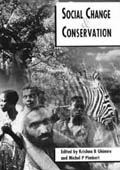Misplaced care
 this book is a rather bold attempt at exploring the complex relationship between man and nature on a larger plane, and conservation programmes and well-being of local people as a specific focus. It delves into the vexing problem of where to draw the line between social and environmental exigencies and how to strike a perfect balance between ecological conservation and human dignity.
this book is a rather bold attempt at exploring the complex relationship between man and nature on a larger plane, and conservation programmes and well-being of local people as a specific focus. It delves into the vexing problem of where to draw the line between social and environmental exigencies and how to strike a perfect balance between ecological conservation and human dignity.
The editors say there is no healthy environment without healthy livelihoods. Failure to respect social justice not only provokes economic misery and conflict but also makes it difficult to mobilise local participation for conservation.
The book is a compilation of contributions on social consequences of protected areas schemes and conservation policies which have far-reaching effect on local populations, often jeopardising their access to resources for their livelihood.
The contributors have done their case studies in diverse geographical locations like Asia, Europe, North and Central America and Africa examples through which they have shown how the local populace's customary rights, social cohesion, cultural identity, and traditional livelihoods are affected, often adversely, by protected area and sanctuary schemes. The endangered populations, in turn, threaten conservation and the viscious circle is thus formed.
This reasoning, however, is likely to raise the hackles of conservationists, as it argues that the interests of animals and plants cannot be put above those of human beings. Protected areas are not just meant for flora and fauna but are social spaces as well.
One of the contributions for example, by Marcus Colchester, says that conservationists have put the preservation of nature above the interests of indigenous people and that the latter have suffered considerable marginalisation due to the former's impositions. He further accuses conservationists of perceiving indigenous people with the same prejudices that confront them everywhere.
In another chapter, Chandana Dey's case study of Jaldapara wildlife sanctuary in West Bengal shows how women living on the fringes of the sanctuary are particularly affected by conservation attempts as they are the ones who venture into the protected area for fuelwood and non-timber forest products and incur the wrath and fines of forest officials. Dey finds it ironical that the forests which once belonged entirely to the people were summarily taken away. He suggests that Joint Forest Management programmes and participatory afforestation schemes might alleviate the situation for indigenous people.
A chapter on management of wildlife, tourism and local communities in Zimbabwe by Christ McIvor holds the colonial masters responsible for dispossessing indigenous people of their traditional farmlands and the post-independence government of not awarding ownership rights to peasants.
This lopsided land re-distribution can be resolved by better management of wildlife, tourism, and local community benefits. The author argues that ownership ought to be extended to the people who have had to live with the adverse consequences of the presence of wildlife for many years.
There are other thought-provoking chapters on the complex relationship between human welfare and biodiversity and a comparison of experiences of protected area management in Costa Rica, a developing country and Germany, an industrialised nation. This controversial book will most certainly provoke a debate which will hopefully evolve a solution for reconciling the interests of wildlife, ecology, and human beings.
